#Henry said ny designs were good today!
Text
I think it’d be funny if William capitalized any pronouns for Henry in his journals hehe
#rlly taking the worship thing to the max#laying on his bed n kicking his feet as he writes w his pink fluffy pen#smthn liek#“dear diary#Henry said ny designs were good today!#Maybe tomorrow I’ll get more compliments from Him :)”#william afton#willry#springshit#shitpost#fnaf#henry emily
60 notes
·
View notes
Text
Lost Chicago Building 2 - The Masonic Temple

Masonic Temple, State and Randolph Streets, Chicago, photograph c.1895-1915, J.W. Taylor, Chicago. Ryerson and Burnham Archives. Marshall Field & Co. is on the right.
Burnham and Root’s Masonic Temple, 1892, whose life span was only 47 years, was for a time the highest building in the world, and a popular and much-illustrated landmark. It stood at the northwest corner of State and Randolph Streets until its destruction in 1939. The building has been extensively documented and written about elsewhere, so I will limit my own comments, and post some illustrations that I haven’t seen on other blogs or history sites.
Unless otherwise noted, all illustrations are from the Ryerson and Burnham Archives, Art Institute of Chicago, available online at http://www.artic.edu/research/archival-collections.

Interior views, Masonic Temple, from The Inland Architect and News Record.
Some colorful descriptions of the building soon after its construction were included in a Chicago Reader article:
Of his first day in Chicago [poet Edgar Lee Masters] remembers that he especially wanted to visit "the tallest building in the world, from the top of which, according to an old Polonius in Lewistown, one could see Council Bluffs, Iowa. I had to try that out, and Uncle Henry took me to the Masonic Temple."
From the mosaic floor of its marble lobby to gabled roofs and glass-domed gardens, the Masonic Temple at the northeast corner of State and Randolph stood 302 feet tall. It was, according to Henry Justin Smith, a managing editor for the old Chicago Daily News, "a wonder of wonders. Everything about the building made the city burst with pride, and gave country visitors kinks in their necks."[1]
The building, by the architectural firm of Burnham and Root of Chicago (Daniel Hudson Burnham 1846-1912 and John Wellborn Root 1850-1891), was Root’s design, as was the firm’s earlier Rookery building, which still stands.
According to architect Louis Sullivan, the term “skyscraper” was born with the Masonic Temple. 22 stories high, the Temple rose 300 feet to the apex of its steeply-pitched roof. The original cost of the building was $3.5 million. Inside, an immense atrium, designed to be a vertical shopping center, was surmounted by a metal and glass canopy. The building was unique both in its height and its concentration of business and mercantile uses.

Atrium, Masonic Temple
The Temple’s exterior design was described at the time as Romanesque; Root had admired the architecture of H.H. Richardson, whose Romanesque style had swept the country in the 1880s.
Its exterior walls were of gray granite and yellow pressed brick. It had a distinct tripartite arrangement, that being a clearly defined base, middle section, and celebratory top; with the Temple architect Root took this concept to its ultimate conclusion, perhaps the best example anywhere. In between top and bottom were the clean and unbroken piers that allowed the building to leap into the sky; their upward force was exhilarating. Each of two massive gables, stretching east-to-west, were punctured with a rank of seven smaller gables. Topside decoration was profuse.[2]
Wrote Thomas Talmadge:
I think that he strove here … to achieve a 'commercial style' based on the Romanesque that might be generally accepted as a formula for the expression of the skyscraper, and he might have prevailed had not the World's Fair almost immediately knocked the hopes of the Romantics into a cocked hat.[3]
Root died of pneumonia in 1891 at the age of 41, as the firm was planning the World’s Columbian Exposition of 1893 in Chicago and before his Masonic Temple was completed.
Architect Philip Johnson, when designing a building on LaSalle Street across from Burnham and Root’s Rookery building in 1984, had remarked snidely,
"We're very proud that our building will be better than the Rookery," said Johnson. "Root wasn't feeling very well when he did that one. His Masonic Temple was a much better building."[4]
Geoffrey Johnson claims that “Johnson's enthusiasm for the Masonic is apparent in his firm's design for 190 South LaSalle,”[5] the tall building’s roof line echoing the twin gables and pitched roof of the Masonic Temple.[6]
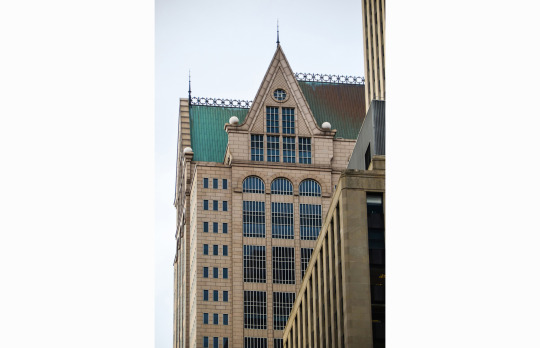
190 S. LaSalle,1987, John Burgee Architects with Phillip Johnson, Shaw Associates. Photo: Chicago Architecture Center

Willis Polk, The Temple, 1901. Drawing, reproduced in Moore, Charles, Daniel H. Burnham Architect Planner of Cities. Boston and New York: Houghton Mifflin Company, 1921, Vol. 1, p. 219. View east on Randolph St.

Illustration from The Inland Architect
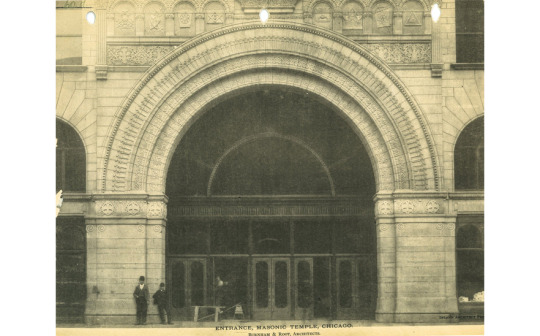
Main entrance; The Inland Architect
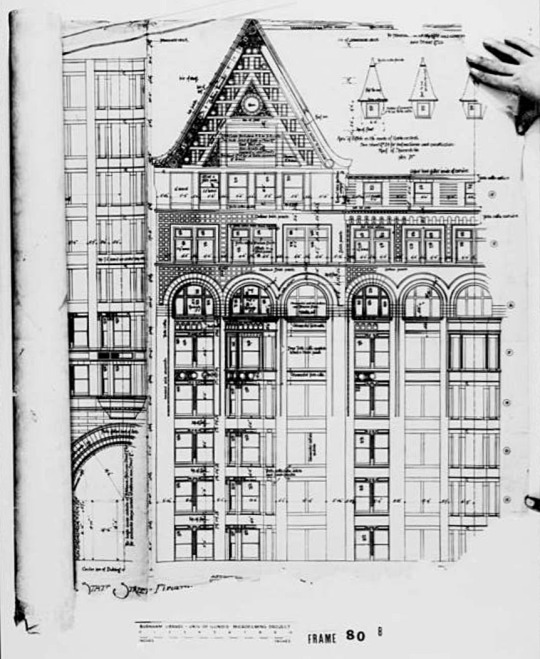
State Street elevation (left half), Burnham and Root

Longitundinal sections of upper stories (left half), Burnham and Root

17th story plan, Burnham and Root

Entrance detail; Snead and Co. Iron Works advertisement
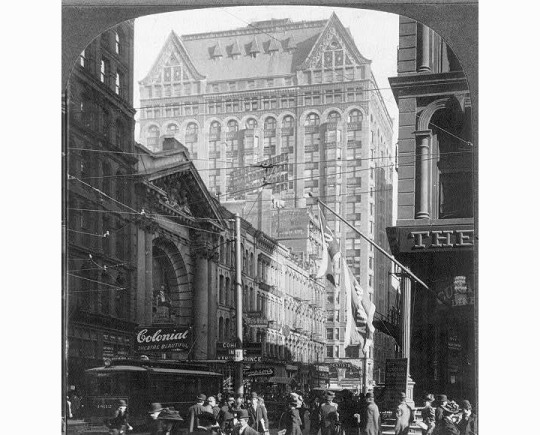
The Masonic Temple from State and Randolph, 1909; from a stereo view, photographer unknown. Image: https://calumet412.com/post/29706348053/the-masonic-temple-from-state-and-randolph-1909

Masonic Temple, souvenir postcard, 1900.
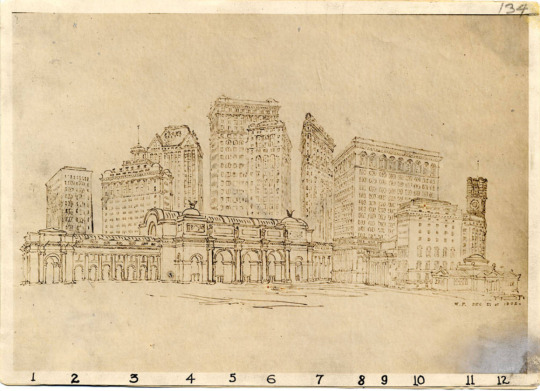
Willis Polk, Composite of buildings, 1902. Depicted are: 1. Union Station and Plaza (Washington, D.C.), 2. Monadnock Building, 3. Merchants Exchange Building (SF, original pre-fire design), 4. Masonic Temple (Chicago, IL), 5. Land Title Trust Building, 6. Frick Building, 7. Flatiron Building (New York, NY), 8. First National Bank Building (Chicago, IL: 1903), 9. Illinois Trust and Savings Bank, 10. Union League Club Building (Chicago, IL: 1902), proposed addition, 11. Chronicle Building, 12. Kenosha Public Library, Simmons Library.
The Masonic Temple is considered one of Root’s three greatest buildings in Chicago, along with the Rookery (1888) and the Woman’s Temple (1892). The Rookery is the only one of the three still standing.
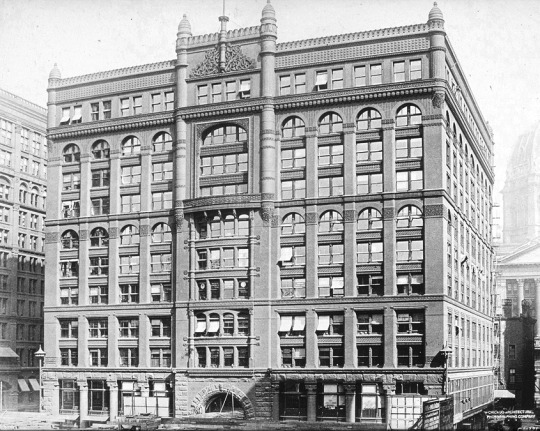
The Rookery Building, 209 S. LaSalle St., 1888, Burnham and Root, architects. Photo: Wikipedia; Library of Congress's National Digital Library Program under the digital ID mhsalad.250063.

Woman’s Temple, Chicago, LaSalle and Monroe Streets, 1892, Burnham and Root, architects (demolished 1926) View from northwest. One Hundred and Twenty-Five Photographic Views of Chicago. Chicago: Rand-McNally, 1902, plate 9.
https://www.researchgate.net/figure/Burnham-Root-Womans-Christian-Temperance-Union-Womens-Temple-Chicago-1892_fig4_259730525
After its destruction, the Masonic Temple was replaced by a nondescript two-story building on the same site, which still exists in altered form:
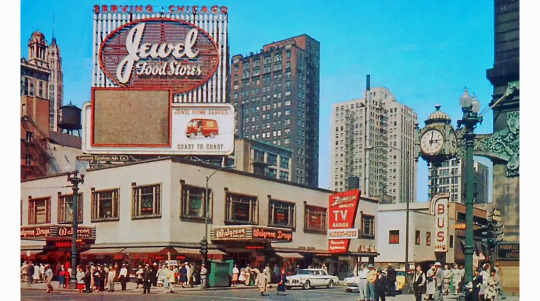
Walgreens, Randolph and State; postcard, 1959; the former site of the Masonic Temple

Ironically, there was a Walgreens occupying the same corner in the Masonic Temple building. The more things change....

The Joffrey Center tower, Booth Hansen Architects, 2008, with 2-story Walgreens on the corner, occupies the site today.
An excellent account of the Masonic Temple’s design and construction process, and the people involved, is here:
Johnson, Geoffrey, “The World's Tallest Building, 1892.” Chicago Reader, September 10, 1987. https://www.chicagoreader.com/chicago/worlds-tallest-building-1892/Content?oid=871104
Other good online sources of information about the building Include:
“Masonic Temple”
Chicagology
https://chicagology.com/goldenage/goldenage026/
“Masonic Temple Cornerstone Laid -- November 6, 1890”
Connecting the Windy City
http://www.connectingthewindycity.com/2014/11/masonic-temple-cornerstone-laid.html
“Masonic Temple by Burnham & Root Built 1892, Demolished 1939”
Preservation Chicago
https://preservationchicago.org/newsletter_posts/masonic-temple-by-burnham-root-built-1892-demolished-1939/
“Masonic Temple Chicago”
Wikiarquitectura
https://en.wikiarquitectura.com/building/masonic-temple-chicago/
NOTES:
[1] Johnson, Geoffrey, “The World's Tallest Building, 1892.” Chicago Reader, September 10, 1987. Online article archive: https://www.chicagoreader.com/chicago/worlds-tallest-building-1892/Content?oid=871104
[2] Korom, Joseph J., The American Skyscraper, 1850-1940: A Celebration of Height. Boston: Branden Books, 2008, p. 176.
[3] Talmadge, Thomas, cited in Johnson, G., op.cit.
[4] Johnson, G., op.cit.
[5] Johnson, G., op.cit.
[6] “190 S. LaSalle,” 1987, John Burgee Architects with Phillip Johnson, Shaw Associates; Chicago Architecture Center. https://www.architecture.org/learn/resources/buildings-of-chicago/building/190-south-lasalle/
#chicago#Architecture#masonic temple#burnham and root#john wellborn root#demolished#landmark#LOOP#richardsonian romanesque
6 notes
·
View notes
Text
tienriu replied to your post “Almost got my ass kicked on an airplane”
Sam, you pulled an adult on some kid. And forgot that you're an actual facts adults. Also I bet you are now being immortalised in a 'this one time -' story a bunch of the people around you are telling.
LOL I’m not even sure if anyone else heard me, you know how airplane accoustics are, but he definitely did. :D I swear I just meant to think it to myself.
I don’t think I ever really internalized that I’m an actual facts adult myself -- it took me realizing that this kid was probably 15-20 years younger than me to realize that I actually appear to have authority.
winds-wanderer replied to your photo “Man, you guys, the Guggenheim is EVEN UGLIER IN PERSON. Nothing...”
Funny stories re the Guggenheim (from former prof who used to work there as an art handler). 1. The walls are a bitch for hanging art. Many drill bits were required. 2. The incline of each floor was too steep for driving small vehicles carrying art work. As for me, the distance between the wall and the rail is too narrow, preventing proper viewing of big art works. So Guggenheim = great architecture, shitty space for displaying art.
Yeah, I did a bit of reading on it and Frank Lloyd Wright never seems to be really interested in the ultimate use of the piece -- I think he was really a frustrated installation artist before they existed (hence the frustration). His architecture was art applied to structure, but he seemed heavily disinterested in what that structure was surrounding.
jeanninedupree replied to your photo “Some photos I didn’t get to post today! Lanterns in a park in south...”
Sam, I don't know if you ever ran across the work of Rex Stout's sister Ruth, but it's well worth your time. She's mainly known as a gardening writer (author of "How to Have a Green Thumb Without an Aching Back") but her book "If You Would Be Happy" is good general philosophy of life.
Oh neat! I wasn’t aware of her, thank you. I’ll add it to my reading queue!
jaythenerdkid-official replied to your photo “Some photos I didn’t get to post today! Lanterns in a park in south...”
I always read that the address of wolfe's brownstone (which changed quite a bit in the books, just like the name of wolfe's lawyer - IS IT NATHANIEL OR IS IT HENRY GEORGE,, REX) would put his house somewhere in the river. that plaque is so cool, though! wolfe is one of my favourite detectives. he and goodwin are my favourite bickering old married couple to go and visit when I'm feeling down.
Yeah, he shared with Conan Doyle a certain lack of concern with the finer details of his stories, but then I think he thought of them as fun little pulps -- he made them as literary as possible and he had some social commentary to make especially in the later ones, but I don’t think he ever thought they’d be seriously studied by people.
There were definitely a lot of addresses I found when I decided I’d go searching for the brownstone (there aren’t any brownstones in that area anymore) but once I happened on the fact that there was a plaque, I decided to take the Wolfe Pack’s word for it :D
sphinxyvic replied to your photo “Some photos I didn’t get to post today! Lanterns in a park in south...”
Gotta show this to Parhelion! We’ll have to look for it next time we’re in NYC!
It’s at 454 West 35th Street -- though I have to warn you there is no brownstone attached to it, it’s just a very nice kind of vintagey-designed apartment block.
thetimesinbetween replied to your photo “Found hipster foodie Steve’s favorite coffee joint. (It is in...”
pause, i live here (in brooklyn)—where is this???
It’s called The Flat BKSpeed Coffee -- I guess it’s kind of a sales point for a coffee micro-roastery in the area?
luthorchickv2 replied to your photo “Well I found something to top yesterday’s Vermeer.”
Was in a cab going up first when i was this post and managed to look out the window at exactly the right moment to see it.
Aw yay, how serendipitous! I actually quite like it, it’s weird and I’m not sure where it’s going but it’s having fun on the way there. According to news coverage, it’s meant to be a welcoming, whimsical first sight on the way to the new children’s hospital that’s going up nearby.
persian-slipper replied to your photo “Well I found something to top yesterday’s Vermeer.”
Who is the artist? It isn't S. Johnson, is it?
No, although there is a Seward Johnson nearby, apparently, I passed close to it on the bus ride back from the doggo. It’s by Donald Lipiski.
laughingacademy replied to your photo “Well I found something to top yesterday’s Vermeer.”
Too bad it wasn't raining, that causes the windshield wipers to turn on.
I HEARD. I was so mad too because it rained later that day!
myotherblogisatardis replied to your post “The little statues are in the 14th St/8th Avenue stop, not 34th. St.”
Ohhhh... Those.... I *hate* those guys!
I have to admit the first ones I saw I was like “Oh, how cute!” and the second one I saw next to it I was like “Well that’s funny!” and then the more I saw the more creeped out I got.
bobcatmoran replied to your photo “Okay kids, you said Ess-A-Bagel so here I am, and bagels aside, the...”
Midwesterner who lived in NY for a few years - I think the thing about NYC bagels isn't necessarily that the best NYC bagels are on a different plane than the best bagels in, say, Chicago. It's that the average NYC bagel is so, SO much better than the average bagel in a Midwestern city, even one as big as Chicago. And they're so ubiquitous.
That makes sense, and the ubiquity I will acknowledge -- the ease of getting a really good bagel in New York is undeniable. If I lived in a city where I could get bagels that good that easily, I’d have a bit of civic pride about it too.
This does, however, reinforce my belief that people who hear the question “Hey where can I get good bagels in XYZ city” and respond “You can’t, go to New York” are being assholes. It’s not helpful, it just generates noise, and it’s worse now! Because it’s SO EASY to find good bagels in New York! New Yorkers should be sympathetic to the plights of those trying to find good bagels elsewhere. It’s the pettiest of punching-down maneuvers.
truly-a-gryffindork replied to your photo “Okay kids, you said Ess-A-Bagel so here I am, and bagels aside, the...”
If you want a side of religious experience with your bagels you’ll have to go to Montreal
I am willing to test this hypothesis the next time I find myself in Montreal!
lh7 replied to your post “Sam I have an important Chicago question: just north of the DuSable...”
hey @copperbadge this post on my blog was flagged
Thank you! Even Tumblr knows how atrocious Seward Johnson’s art is. I’ve had it unflagged.
fanmouse replied to your photo “IT HAS BEEN A VERY EXCITING DAY. I went to Tal’s bagels for breakfast...”
I want to know if one of the silver pitchers in the Met collection belonged to Vermeer (or the model). Wishing you safe travels.
I actually backtracked yesterday morning to the public-access storage room and went through the rack of silver pitchers looking for one that matched, but alas, none had the right shape and spout.
melinda-t-charville replied to your photo “Funnily enough mum used to complain that people randomly followed her...”
Thank you! I was able to find it now - you must have got a good deal bc they're selling it for $20 on Amazon!
Oh lord, you can definitely find it cheaper than that -- I saw it for like $8 using Google Shopping. Good luck in your quest!
#melinda-t-charville#fanmouse#lh7#truly-a-gryffindork#bobcatmoran#myotherblogisatardis#laughingacademy#persian-slipper#thetimesinbetween#luthorchickv2#sphinxy-vic#jaythenerdkid-official#jeanninedupree#winds-wanderer#tien-riu
34 notes
·
View notes
Text
KANT BE SO
Yes, a cheesy title, but in its way, it hits the point of this posting. This blog, after rendering a cursory description of how Romanticism got started in Europe, now begins describing its introduction into the US. And in that, one comes across familiar titles: “The Legend of Sleepy Hollow” by Washington Irving along with his “Rip Van Winkle.” There’s James Fenimore Cooper’s The Last of the Mohicans and the depiction of Puritanical morals in Nathaniel Hawthorne’s The Scarlet Letter and Herman Melville’s Moby-Dick.
But of direct interest to this blog are the essays and other non-fiction works of Henry David Thoreau and Ralph Waldo Emerson. And with these efforts, one can see that many Americans readily took up the themes their European counterparts had been expounding. That included a high dose of moral judgement, an emphasis on individualism – from a more psychological perspective – and the importance of intuition, more on this in a bit.
They also promoted an almost reverence for nature – especially in the case of Thoreau – in which the message was it was “naturally” good while society was indulgent and corrupt. Of course, as the last posting described and explained, these themes were recurring in Romantic offerings in Europe as those artists and writers took aim at the Enlightenment’s reliance on reason. And to underline this divorce from Enlightened thought, American Romantics hit upon a term that they felt emboldened their disdain, that being transcendentalism.
Why? That question takes one back to Europe. There, the origin of this anti-reason strain gets an initial upstart not from an anti-reason argument, but one that placed certain restraints found in the works of Thomas Hobbes and John Locke. In their works – to use a Lockean term – the mind at birth was a tabula rasa, a blank slate.
It, then through experience, perhaps resulting from the succession of rewards and costs that one encounters, one “learns” to see those things that one should pursue and what one should avoid among what all those encounters teach a person. In that one learns, from observing how one’s mind works, to reason since reasoning increases the probability of success. To that argument, Immanuel Kant sought to qualify it.
He did not argue that reason and the ability to reason were not important aspects of learning and decision-making, but he claimed there was more going on in the mind and those processes of sorts were inborn abilities. And that needs to be explained. To begin, yes, at birth one experiences and/or observes isolated things out in one’s surroundings, but that is all a subject can do that relates to his/her reasoning ability.
That is, each encounter is merely observing a sensation. At that stage, reason could not do anything with each sensation or, to use the jargon, each thing-in-itself. As such, each is phenomenal, or datum and one cannot pass any judgement about it. To this point, there is agreement with David Hume in that Hume’s skepticism questioned the human ability to draw any conclusions even if colliding billiard balls then move away from each other.
But, Kant adds, that upon that pure information, one has built-in a mental capacity – not based on experience – that allows one to make judgements of what underlies or constitutes those experiences. And that is what Kant called with the unfortunate term, noumenal (roughly pronounced new-ou-min-al).
This noumenal is a totally different realm of knowledge into which the mind can tap. It is through this element that the mind can investigate the nature of things or to pass judgement as to its ultimate truthfulness, its functionality, its morality, and other qualities that transcend its physical qualities, i.e., beyond one’s observation of the things-in-themselves. And here, according to Kant, one does not use reason – reason only deals in the phenomenal.[1]
All of this review reminds this blogger of what he reads concerning contemporary psychological study of these human, mental abilities and processes. For example, Nobel prize winner, Daniel Kahneman, writes:
Our everyday intuitive abilities are no less marvelous than the striking insights of an experienced firefighter or physician – only more common …
[quoting Herbert Simon] “The situation has provided a cue; this cue has given the expert access to information stored in memory, and the information provides the answer. Intuition is nothing more and nothing less than recognition.” …
An important advance is that emotion now looms much larger in our understanding of intuitive judgements and choices than it did in the past. [An] executive’s decision would today be described as an example of the affect heuristic, where judgements and decisions are guided directly by feelings of liking and disliking, with little deliberation or reasoning.[2]
All this gets heavier as one plunges into Kant, and the purpose here is not to do so – even if this writer could – but to give the reader a sense of why Romantic Americans adopted the term transcendentalism. In doing so, they probably extended Kant’s purposes, but it did fit into what they wished to promote. As with their European counterparts, they had an attitude against reason and Kant’s transcendent argument fit their designs. Allen Guelzo explains:
There were, Kant said, two things which amazed him – the starry heavens above, which were phenomenal, and the moral law within which belonged to the noumenal. Never the twain would meet, at least methodologically. Philosophy could not become transcendent. But, through the gift of the noumenal, it could become transcendental. Reason, and all of its limitations, half heartedness, and sterility, could retire off the stage and minds could rejoice in knowing the certainty of external phenomena and the intuition of transcendental wonder.[3]
And wonder seems to be what many Americans were searching to find in the 1820s and 1830s.
As with the Great Awakening, the first signs of this transcending that is Transcendentalism appears in the Boston area. It devolved from Unitarianism, a Protestant sect springing from the days of the Great Awakening, on the Harvard campus. By the early 1800s, it had become the most prominent religion in the Boston area.
Upon the election of Henry Ware as a professor of divinity as early as 1805 and the ascension of John Thornton Kirkland as president of that college in 1810, a certain natural evolution from Unitarian beliefs took hold, an outgrowth or sort of rebellious thinking that promoted free consciousness and initially valued intellectual reasoning.
But this view moved on and began to question such Unitarian biases of mildness, sobriety, and cool rationalism. They, the self-anointed Transcendentalists, sought more intensity. Parallel to otherwise Unitarian beliefs, they went looking for more visceral spirituality in their beliefs and in the religious experiences that they encountered.[4] These notions took root and led to the eventual founding of the Transcendental Club in Cambridge in 1836 under the leadership of George Putnam, Ralph Waldo Emerson, and Frederick Henry Hedge.
The club had female members and of note, Thoreau was also a member. It published a journal, The Dial. But the club and its movement did not enjoy widespread influence during the 1840s. As a matter of fact, it did not hit its stride until later in the mid-nineteenth century. At that time, Transcendentalism influenced a growing movement known as the “Mental Sciences.” Later, it took on the name “New Thought.” It considered Emerson its intellectual father as well as depending on a long list of influential British writers of those years.[5]
It turns out that these Americans had little direct exposure to European Romantics and most of what they understood or knew of them came to them through the works of Thomas Carlyle and Samuel Taylor Coleridge. It is through their presentation of Romantic ideas that this blog will next look at and report on their influence.
[1] Henry E. Allison, “Kant, Immanuel,” in The Oxford Companion to Philosophy, edited by Ted Honderich (New York: Oxford University Press, 1995), 435-438.
[2] Daniel Kahneman, Thinking, Fast and Slow, (New York, NY: Farrar, Straus, and Giroux, 2011), 11-12.
[3] Allen C. Guelzo, The American Mind, Part II – a transcript book – (Chantilly, VA: The Teaching Company/The Great Courses, 2005), 23-24.
[4] Ian Frederick, “The Emergence of Transcendentalism,” American Studies at The University of Virginia, University of Virginia (November 2014), accessed September 13, 2021, Rise of Transcendentalism (virginia.edu) .
[5] “New Thought,” MSN Encarta, Microsoft (November 11, 2002), accessed September 13, 2021, New Thought - MSN Encarta (archive.org) .
#Romanticism#Transcendentalism#Immanuel Kant#noumena#phenomena#intuition#reason#civics education#American history#social studies
0 notes
Text
Identifying extreme impact in research, Clarivate Analytics uses citations to forecast Nobel Prize winners
Of 22 named researchers, first Russian Citation Laureates selected
PHILADELPHIA, Sept. 20, 2017 /PRNewswire/ -- Clarivate Analytics, the global leader in providing trusted insights and analytics to accelerate the pace of innovation, today announced its 2017 Citation Laureates.
Each year since 2002, analysts at Clarivate Analytics have mined millions of citations in the Web of Science to identify top-tier researchers in physiology or medicine, physics and chemistry -- fields recognized by the Nobel Prizes in science. It also names Citation Laureates in economics since the Swedish National Bank established an award in this domain, in memory of Alfred Nobel, in 1968.
Citation Laureates are scientists and economists whose publications have been cited so often by their colleagues -- and thus who have been so influential -- that they are forecast as potential recipients of the Nobel Prize in this year or in the future.
In 15 years, 43 Citation Laureates have gone on to receive Nobel honors.
A good bet for a Nobel Prize this year may be the award in Physics for the detection of gravitational waves resulting from the coalescence of black holes, something predicted by Einstein more than a century ago. The likely recipients would be Kip S. Thorne of Caltech and Rainer Weiss of MIT, who were named Clarivate Analytics Citation Laureates last year.
There are many noteworthy nominees. For the first time, Russian scientists have been named Citation Laureates. This year's cohort also includes researchers from Denmark, Germany, Greece, India, Japan, The Netherlands, South Korea and Taiwan, as well as from the UK and USA. They are listed below.
The 2017 Clarivate Analytics Citation Laureates:
PHYSIOLOGY or MEDICINE
Lewis C. Cantley
Meyer Director and Professor of Cancer Biology, Sandra and Edward Meyer Cancer Center, Weill Cornell Medical College, New York, NY, USA
For discovering the signaling pathway phosphoinositide 3-kinase (PI3K) and elucidation of its role in tumor growth
Karl J. Friston
Professor of Imaging Neuroscience and Wellcome Principal Research Fellow, Wellcome Trust Centre for Neuroimaging, University College London, London, UK
For fundamental contributions to the analysis of brain imaging data, specifically through statistical parametric mapping and voxel-based morphometry
Yuan Chang
American Cancer Society Research Professor, Distinguished Professor of Pathology, and UPMC Endowed Chair in Cancer Virology, University of Pittsburgh School of Medicine, Pittsburgh, PA, USA
-and-
Patrick S. Moore
Director of the Cancer Virology Program, University of Pittsburgh Cancer Institute, American Cancer Society Research Professor, Distinguished Professor of Microbiology and Molecular Genetics and the Pittsburgh Foundation Chair in Innovative Cancer Research, University of Pittsburgh School of Medicine, Pittsburgh, PA, USA
For their discovery of the Kaposi's sarcoma-associated herpes virus, or human herpesvirus 8 (KSHV/HHV8)
PHYSICS
Phaedon Avouris
IBM Fellow and Group Leader for Nanometer Scale Science and Technology, Thomas J. Watson Research Center, Yorktown Heights, NY, USA
-and-
Cornelis (Cees) Dekker
Distinguished University Professor and Director of the Kavli Institute of Nanoscience, Delft University of Technology, Delft, The Netherlands, Delft, The Netherlands
-and-
Paul McEuen
John A. Newman Professor of Physical Science, Department of Physics, Cornell University, Ithaca, NY, USA
For seminal contributions to carbon-based electronics
Mitchell J. Feigenbaum
Toyota Professor, Laboratory of Mathematical Physics, Rockefeller University, New York, NY USA
For pioneering discoveries in nonlinear and chaotic physical systems and for identification of the Feigenbaum Constant
Rashid A. Sunyaev
Director and Scientific Member at the Max Planck Institute for Astrophysics in Garching, Germany (since 1995), Head of the High-Energy Astrophysics Department of the Institute for Space Research, Russian Academy of Sciences, Moscow (in 1982 - 2002; Chief Scientist since 1992); Visiting Professor of the Institute for Advanced Study, Princeton (since 2010), Moscow, Russia
For his profound contributions to our understanding of the universe, including its origins, galactic formation processes, disk accretion of black holes, and many other cosmological phenomena
CHEMISTRY
John E. Bercaw
Centennial Professor of Chemistry, Emeritus, Division of Chemistry and Chemical Engineering, Caltech, Pasadena, CA, USA
-and-
Robert G. Bergman
Gerald E.K. Branch Distinguished Professor, Department of Chemistry, University of California Berkeley, Berkeley, CA USA
-and-
Georgiy B. Shul'pin
Senior Scientific Researcher, N. N. Semenov Institute of Chemical Physics, Russian Academy of Sciences, Moscow, Russia
For critical contributions to C-H functionalization
Jens Norskov
Leland T. Edwards Professor in the School of Engineering and Professor of Photon Science and Senior Fellow at the Precourt Institute for Energy, Department of Chemical Engineering, Stanford University, Stanford, CA, USA
For fundamental advances, theoretical and practical, in heterogeneous catalysis on solid surfaces
Tsutomu Miyasaka
Professor of Photoelectrochemistry and Energy Science, Faculty of Biomedical Engineering and Graduate School of Engineering, Toin University of Yokohama; group leader of national research projects funded by Japan Science Technology Agency (JST) and Japan Aerospace Exploration Agency (JAXA), Yokohama, Japan
-and-
Nam-Gyu Park
Professor, School of Chemical Engineering, Sungkyunkwan University, Seoul, South Korea
-and-
Henry J. Snaith
Professor in Physics, Clarendon Laboratory, University of Oxford, Oxford, UK
For their discovery and application of perovskite materials to achieve efficient energy conversion
ECONOMICS
Colin F. Camerer
Robert Kirby Professor of Behavioral Finance and Economics, Division of Humanities and Social Sciences, and Tianqiao and Chrissy Chen Center for Social and Decision Neuroscience Leadership Chair, Caltech, Pasadena, CA, USA
-and-
George F. Loewenstein
Herbert A. Simon University Professor of Economics and Psychology, Carnegie Mellon University, Pittsburgh, PA, USA
For pioneering research in behavioral economics and in neuroeconomics
Robert E. Hall
Robert and Carole McNeil Joint Hoover Senior Fellow and Professor of Economics, Stanford University, Stanford, CA, USA
For his analysis of worker productivity and studies of recessions and unemployment
Michael C. Jensen
Jesse Isidor Straus Professor of Business Administration, Emeritus, Business School, Harvard University, Cambridge, MA, USA
-and-
Stewart C. Myers
Robert C. Merton (1970) Professor of Financial Economics, Emeritus, Sloan School of Management, MIT, Cambridge, MA, USA
-and-
Raghuram G. Rajan
Katherine Dusak Miller Distinguished Service Professor of Finance, Booth School of Business, University of Chicago, Chicago, IL, USA
For their contributions illuminating the dimensions of decisions in corporate finance
"Analysis that begins with and mainly depends on highly-cited papers, allows Clarivate Analytics to objectively identify excellence in research," said Jessica Turner, global head of the Scientific and Academic Research business at Clarivate Analytics. "It is our honor to recognize trailblazing researchers and we hope this designation is an honor for them. Our analysis faithfully reflects what their colleagues' citations have already indicated about the influence and importance of the Citation Laureates' research contributions. However, our analysis only reflects what their colleagues have already indicated about the influence and importance of the Citation Laureates' research contributions.
"This is what we do," she added, "we comprehensively record and carefully analyze scientific and academic research to provide a clear and accurate window on the world of research."
For detailed information on the methodology of this study, the Citation Laureates and their fields of research and institutional affiliations visit: http://ift.tt/2fAwgIR
Follow @Clarivate, @WebofScience and #CitationLaureate on Twitter for up-to-the-minute news on the predictions and deeper insight into their fields of research.
Clarivate Analytics
Clarivate™ Analytics is the global leader in providing trusted insights and analytics to accelerate the pace of innovation. Building on a heritage going back more than a century and a half, we have built some of the most trusted brands across the innovation lifecycle, including the Web of Science™, Cortellis™, Derwent™, CompuMark™, MarkMonitor® and Techstreet™. Today, Clarivate Analytics is a new and independent company on a bold entrepreneurial mission, to help our clients radically reduce the time from new ideas to life-changing innovations. For more information, please visit clarivate.com.
Read this news on PR Newswire Asia website: Identifying extreme impact in research, Clarivate Analytics uses citations to forecast Nobel Prize winners
0 notes